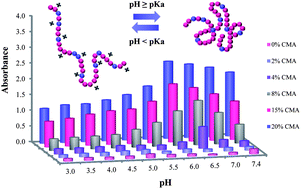Reversible addition–fragmentation chain transfer (RAFT) polymerization was used to generate well-defined pH-responsive biofunctional polymers as potential ‘smart’ gene delivery systems. A series of five poly(dimethylamino ethyl methacrylate-co-cholesteryl methacrylate) P(DMAEMA-co-CMA) statistical copolymers, with similar molecular weights and varying cholesterol content, were prepared. The syntheses, compositions and molecular weight distributions for P(DMAEMA-co-CMA) were monitored by nuclear magnetic resonance (NMR), solid-state NMR and gel permeation chromatography (GPC) evidencing well-defined polymeric structures with narrow polydispersities. Aqueous solution properties of the copolymers were investigated using turbidimetry and light scattering to determine hydrodynamic diameters and zeta potentials associated with the phase transition behaviour of P(DMAEMA-co-CMA) copolymers. UV-Visible spectroscopy was used to investigate the pH-responsive behaviour of copolymers. Hydrodynamic radii were measured in the range 10–30 nm (pH, temperature dependent) by dynamic light scattering (DLS). Charge studies indicated that P(DMAEMA-co-CMA) polymers have an overall cationic charge, mediated by pH. Potentiometric studies revealed that the buffering capacity and pKa values of polymers were dependent on cholesterol content as well as on cationic charge. The buffering capacity increased with increasing charge ratio, overall demonstrating transitions in the pH endosomal region for all five copolymeric structures. Cell viability assay showed that the copolymers displayed increasing cytotoxicity with decreasing number of cholesterol moieties. These preliminary results show the potential of these well-defined P(DMAEMA-co-CMA) polymers as in vitro siRNA delivery agents.
Synthesis, self-assembly and stimuli responsive properties of cholesterol conjugated polymers by Sema Sevimli, Sharon Sagnella, Maria Kavallaris, Volga Bulmus and Thomas P. Davis Polym. Chem. 2012, 3, 2057-2069.
To keep up-to-date with all the latest research, sign up for the journal’s e-alerts or RSS feeds or follow Polymer Chemistryon Twitter or Facebook.











